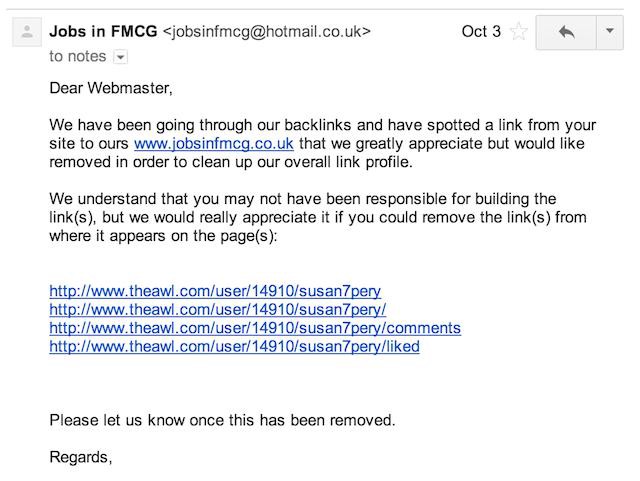The Golden Era Of Spam Comments Has Ended
by Brendan O’Connor

The search engine optimization community has spent the last two years in a panic. SEO people flood our Internet with spam links and fake Twitter bots and paid traffic, to help bad websites look more popular than they are, to deliver fake viewers to web ads.
They now spend their lives on the run, Google nipping at their heels. Their biggest project? Removing all the spam links on websites like this one — the spam links that they put there.
In early 2011, Google issued an update to its search algorithm — they called it “Panda” — that elevated social media and news sites. Sites both big and small, usually spammy and sometimes not, saw major decline in their Google traffic. Companies like About and Mahalo and eHow cratered. Google said they wanted for “the ‘good guys’ making great sites for users, not just algorithms, to see their effort rewarded.”
In spring of 2012, Google moved on from Panda to Penguin, which further refined that goal, though still the updates sometimes had a negative effect on non-spam sites, cutting traffic to older and larger sites.
But it was the Penguin 2.1, released in October, that sent spammers to the bitter edge; now they can’t repent fast enough for their spammy sins.
Given how ubiquitous the act of Googling something has become, it is easy to forget how much goes into returning search results. “Google’s algorithm takes into account dozens of criteria,” wrote the New York Times in 2011, after J.C. Penney was penalized for having paid a search-engine optimization firm to place incoming links around the web. “But it has described one crucial factor in detail: links from one site to another.”
Essentially, the more your site is linked to across the web, the higher Google will rank you, and links from sites that are similar to your own are better than links from sites that have nothing to do with anything. Over time, the quality of those links has become more and more important. (This 43-page PDF from Google is more specific, if you’re really interested.)
Those links, in part, have an effect on one’s placement in search results. Many of the J.C. Penney spam links were published on web sites that seemed to exist solely for that purpose: as a space for spam links to live. Out of the way, they never intruded directly on the experience of the average internet user (who may or may not be a robot anyway).
But: what’s the easiest way to place a link on a site you don’t own? Why, it’s blog comments.

Hairpin user “michaeljohn,” you will see, has a lot of substantive contributions to make to the conversation, like “buy bongs.” (Fun!) We call this “black hat” linking. Web publishers — even as they pine for Google’s affections, or at least play by Google’s rules — are besieged by such comments.
So the black hat spam folks who spread these links across the Internet have reversed course. The Awl, and other websites like it, receive email after email each day from companies requesting that we help them clean up their presence in the comments, deleting links posted by fake accounts, the log-in information for which has long been lost or never recorded.
This isn’t only happening in The Awl’s inboxes, either. “The funny thing is, we don’t actually want that spam lurking around in old comments,” Boing Boing’s Rob Beschizza wrote to me in an email. “But we obviously like seeing the spammers suffering as a result of their own misbehavior.”
“So we just leave it up,” he wrote, “even though we don’t want it, in the hope that Google may penalize them further.”
And exactly what form do those penalties take?

“For 500 keywords that we track, 90% of them were on page one,” Or Hillel told me over Skype. (“Keywords” are usually the words associated with the linked site; if your link is to a gambling website, well, “gambling” is a good keyword.) Hillel has worked in SEO for the past eight years and was, a few months ago, hired to be the Inbound Marketing Manager at MyCurrencyTransfer.com — tasked to protect the brand. As is often the case, one SEO person is undoing the previous work of long-gone SEO people.
“The average drop was from page one to page five in Google,” he said. In some cases they even dropped as low as page ten. How often do you find yourself on the fifth — much less the tenth — page of Google results? If you’ve gotten that far, you’re better off just refining or revising your search terms.
“We needed to delete all of the bad links,” he said. “It was a big list — a few thousand, even ten thousand links. We just moved one by one: this is a toxic link, we need to delete it; this is a good, natural link.”
“We had links from the Daily Mail, Huffington Post, and we had links from profiles in shitty forums or small websites that we didn’t want to get the link from,” he said. Apparently by that he meant… us. So the goal clearly isn’t to remove all spam links. Just the least-good ones.

This is very sneaky, what they had done here. They made a commenter profile — and then put the spam link in the commenter profile’s description. Clever.
I asked Hillel whether they considered hiring the SEO company who had placed those links to begin with to clean up the mess they’d made.
“That’s a problem. It’s a freelance company that no longer exists,” Hillel told me. “I don’t know the name of the company. Is it important?”
A few minutes after I hung up with Hillel, his boss, Dan Abrahams, one of the co-founders of My Currency Exchange, called me on my phone. He asked about the article, and whether I could keep his company’s name out of the story. They’re very protective of their brand’s identity, he said, and didn’t want to be associated with these kinds of shady practices. Which is why, presumably, they paid a bunch of spammers — “freelancers from the Philippines” — in the first place.
Abrahams wasn’t able to find any records of his company’s business with the (allegedly) now-defunct SEO firm, either. You think there’d be a receipt somewhere.
My Currency Exchange isn’t the only B R A N D to reach out to The Awl, asking for links that they paid for to be removed. (Also, not every SEO company has figured all this out! There are still people paying people to place spam comments on sites like this one.)
My favorite are the emails from OneFlare.com.au.
“We have discovered that a company we hired to help promote our website have used a variety of questionable techniques to secure links,” Selena Le wrote on October 20th. “These links were placed purely for SEO purposes, with the intention of manipulating search rankings.”
“We have discovered that a company we hired to help promote our website have used a variety of questionable techniques to secure links,” Nick Chernih wrote on December 5th. “These links were placed purely for SEO purposes, with the intention of manipulating search rankings.”
You don’t say.

“The presence of these links is harmful to our site’s good standing with search engines,” the good people from Oneflaire.com.au each wrote. “Unfortunately, retaining them may also be potentially harmful to your own website’s reputation.
Very threatening! And fairly hilarious: If you do not delete these comments that we paid to have placed on your site, Google will punish you.
That’s possibly true. “Generally, it’s fine for sites to have paid links as long as they’re clearly labeled as ads and don’t pass PageRank,” a Google spokesperson wrote to me via email. “We may take action on sites that don’t follow our quality guidelines.”
Beschizza isn’t worried. Google, he wrote, has said “they’re not going to penalize users or disavowed links.”
“I would hope there are still implicit consequences for asking Google to do this,” he wrote. “It is a rather obvious admission of foul play, and while Google may forgive, it surely does not forget.”
“www.theawl.com has a number of links pointing to our site,” wrote a man named Ben, who identified himself as the owner of Identity Theft Protection dot org. “We would appreciate it if you removed them as soon as possible. We would be happy to provide you with a full count and list of the links if you would like.”

“We understand that you may have not been responsible for building the link(s),” wrote “Jobs in FMCG,” “but we would really appreciate it if you could remove the link(s) from where it appears on the page(s).”
Indeed, The Awl certainly was not responsible. Who was? “The excuses are always choice,” Beschizza wrote. “My favorite one is that a competitor put their spam there. You know, as if a competitor would have thought, in 2007 or so, “Let’s put out spam promoting our rival’s site, just on the off chance than in five years Google will penalize them!”

What then, is an SEO firm to do? “The best way to get other sites to create high-quality, relevant links to yours is to create unique, relevant content that can naturally gain popularity in the Internet community,” Google says. Simple enough! If you build it, they will come, and all that. Still, even if you build it, they still need to be able to search for it, which is why they have this nice, 32-page Search Engine Optimization Starter Guide.
So the new SEO tactic is to email hustling for links — good links, not obvious spam links. “I noticed that you mentioned a page on the FDA’s website — I’m not sure if you heard, but the FDA stepped down from a lawsuit with the tobacco companies earlier this year that required the graphic warning labels,” a Sarah Green emailed us to say recently. (Real name? probably not.) She goes on to offer a link to an anti-cigarette lobbying group. (Barking up the wrong tree, as they say.) She closed: “Just wanted to give you a heads up :-).”
The other, more fascinating method, is that offered by the online marketing manager who identified herself only at “Monika” when she emailed The Awl. Now, Monika ain’t no dummy. Homegirl knows what the score is.
“SEO is dead as we know it,” Monika wrote. “The old math of increased back links and stuffing keywords is now a target to identify your site and bury it in the search results.”
“SEO is no longer a math problem,” she wrote. “It’s a human one. Social indicators are becoming key to Ranking and link algorithms are being retired.”
“It’s time for you to see the truth about SEO and adjust accordingly.”
I have seen the truth, and it’s Monika’s THIRTY-SEVEN POINT PLAN to get The Awl to the “1st Page at Google.” (That was actually the subject line of her email.)
Here below is the content marketing activities “Monthly Task and responsibilities”
1. 200 Press Release Submissions (20 press release x 10 press release websites)
2. 20 Press releases, 400+ words written
3. 5 Unique Articles will be written
4. 5 Web 2.0 Properties will be made
5. 5 Unique “how to Articles” will be written
6. 5 Face book Pages will be created
7. 5 Twitter channels will be created
8. Will increase twitter followers?
9. 1 YouTube channel will be created
10. 10 YouTube videos will be created by Animoto.com (paid)
11. Will likes, shares, tweets, reedits, and 1+ in order to get natural back links
12. Anchor text diversity (will not use exact keywords for back links).
13. Will get Natural back links by link worthy articles
14. Will draft & submit 5 articles to Ezinearticles.com
15. Will create Google+ page for your business
16 will distribute 15 posts daily via Google+ Page
17. Will participate in Forum
18. Will create blog for your website
19. Will make 1 post daily on your blog
20. Will bookmark real content to leading 150 Social Book marking sites as dig, delicious
21. Will submit your website to 10 leading Web directories as Dmoz.org On-Page work activities “Follow only first month”.
22. Meta tags/Title tag changes
23. Keyword research/Analysis
24. Competitor Analysis
25. Analysis by our Paid Seamus Program
26. Heading tag changes
27. Alt tag changes
28. Interlinking wherever required.
29. Keyword density in site content.
30. HTML Site Map
31. XML site map and Submission in webmaster tool
32. Ror.XML File creation
33. Robots.Txt File creation Extra work activities
34. Google Webmaster tools
35. Google Analytics
36. Html to text ratio optimization
37. Keyword Prominence
Sounds interesting? Feel free to email us or alternatively you can provide me with your phone number and the best time to call you.
Many Thanks
Monika
How exhausting. But I think we should go for it, honestly.
Brendan O’Connor is a writer in New York. Photo by Dan Foy.
